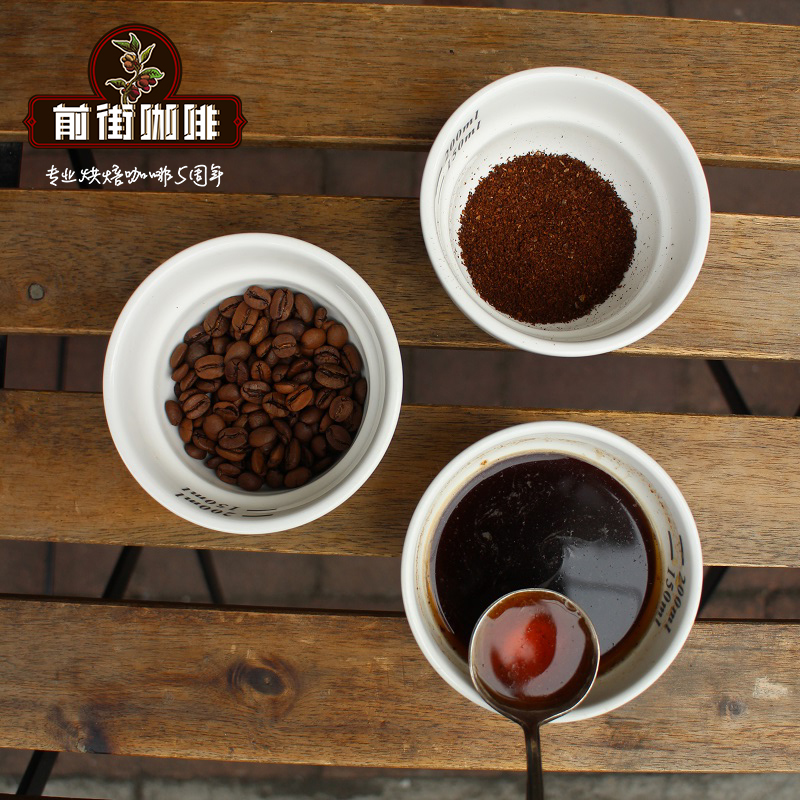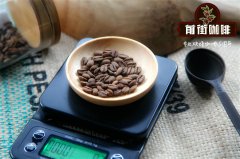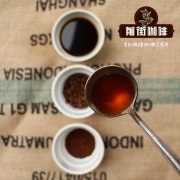Kopi Luwak | principle of in vivo fermentation of civets? Sidamo candlelight exquisite sun fermentation treatment?

Professional coffee knowledge exchange more coffee bean information please follow the coffee workshop (Wechat official account cafe_style)
Kopi Luwak | principle of in vivo fermentation of civets? Sidamo candlelight exquisite sun fermentation treatment?
The sun-drying method shows a strong aroma of wine, which is the most primitive, simple and oldest treatment of coffee. According to relevant literature, Arabs began to use the sun method to treat the fruits of coffee as early as 1000 years ago in the 11th century.
Process:
First pour the coffee beans into a large tank, the underdeveloped inferior beans will float on the surface, pick up the ripe and full fruits that sink to the bottom of the water, lay them in the sun, and often turn them over to pick out defects.
When the water content in the coffee beans is reduced to 10%-14%, the peel pectin can be knocked off with a sheller, and the whole solarization method is complete.
Disadvantages:
The sun method depends entirely on the weather, and the dryness of coffee fruit is difficult to control. If the sun is not clean, it is easy to mix with impurities. In the process of the sun, the pulp of the coffee fruit has not been removed, so it is often moldy and rotten. Therefore, in the view of many people, the quality of sun-exposed coffee beans is not controllable and the level is not too high.
Advantages:
Except for the first step of using water to filter out shoddy beans, the other steps no longer need any water and can be used repeatedly. In areas where water resources are not abundant, this method is amazing. And because sun-dried beans have irreplaceable special flavor, some excellent farms begin to take sun-dried beans seriously, such as putting them on shelves to prevent pollution and fine selection, so today we can see a lot of high-quality sun-dried coffee beans.
Flavor: although the sun-dried beans are uneven in appearance and different in color, because the coffee beans ripen naturally inside the fruit and are not disturbed by the external environment, the sun-cured coffee beans have a stronger flavor, fermented like wine and sweet.
Washing method:
Wash with water and give a clean sour smell
Because of the shortcomings of the solarization method, the Dutch invented the washing method in the mid-18th century, which was widely favored. The biggest difference from the sun method is that it uses fermentation to remove the skin.
Treatment process: as in the first step of the solarization method, the inferior beans are removed first, and then the peel and pulp of the coffee fruit are knocked off with pulping machine (pulp planer). Throw it into the sink to ferment for 16-36 hours, and the fermentation bacteria dissolve the pectin.
In order to remove the residue of fermentation bacteria and impurities, the coffee beans are washed again, and then the coffee fruit is dried by machine to reduce the moisture content to 10% Murray 14%. Finally, the use of shelling machine to remove the silver skin on the coffee beans can be completed.
Disadvantages: the washing method, as its name implies, mostly requires water, but this method is not likely to be adopted in some countries that lack water resources. The process of washing is also relatively cumbersome and the cost is much higher than that of tanning.
Advantages: after layers of screening and cleaning, the appearance and taste will be cleaner and more uniform. And because the flesh is removed in the first place, you don't have to worry about mildew as much as the sun.
Flavor: washed beans usually have bright and clean acidity because they ferment acid in the fermentation tank.
Semi-washing method:
Half-washed, pectin is completely eliminated, because the water-washing method requires too much water, so the semi-washing method was born. It is a mixture of sun exposure and water washing, and it is also a compromise between the two.
Treatment process
First, it is the same as the above two treatments, first remove the shoddy beans; then pour the coffee fruit into the pulping machine (pulp planer) to remove the peel and pulp.
In order to reduce water consumption, semi-washing uses demucilager (pectin scraper) to remove pectin, and finally the coffee fruit is dried or exposed to outdoor exposure.
Reduce the water content of the coffee fruit to 10% Murray 14%, and then use the sheller to remove the silver skin sticking to the coffee beans, that is, complete!
Disadvantages: although it is a mixture of washing and tanning, its process is as tedious as washing.
Advantages: it has the cleanliness of washing method, and it doesn't need to consume a lot of water.
Flavor: the semi-washing method has the least influence on the quality, and the sour taste of coffee is lower than that of washed beans and higher than that of sun-washed beans; the sweet taste is lower than that of honey treatment, but the cleanliness is better than that of honey treatment, and the flavor is between honey treatment and water washing.
Honey treatment method:
Honey treatment, pectin honey to produce sugar
Honey treatment (Miel Process in Spanish) is also called half-sun treatment. It is the most fashionable and characteristic treatment in recent years, and the main difference between it and the sun method is whether the pulp is removed before or after the sun.
Treatment process: similarly, the first step is still to remove the inferior beans, and then through the pulping machine (pulp planer), remove the peel and pulp, and then sun, so that the water content of the coffee fruit is reduced to 10% 14%. Finally, you can use the sheller to remove the silver skin sticking to the coffee beans.
Disadvantages: among the several mainstream coffee bean processing methods, it is the most complex and painstaking.
Advantages: it belongs to the improved method of tanning, which effectively changes the problem of mildew of coffee beans and reduces the cost of water.
Flavor: because it is exposed to the sun with pectin, the sugar in the pectin enters the beans during the drying process, making the coffee beans sour and sweet and mellow. In recent years, the winners of many competitions have come from the honey treatment process, which is quite famous in Costa Rica.
Fermentation (in vivo fermentation of civets)
Animal body fermentation, pull out gentle mellow, about animal body fermentation, Xiaobian personally feel is extremely cruel, the most typical is civet coffee (Kopi Luwak).
Principle:
The lactic acid bacteria and digestive juices in the digestive tract of animals are used to remove the pectin from the pulp and the surface of the pods. The beans are excreted with the feces, and after cleaning, they are precious grains of fermented beans in the body. In addition to the civets, there are also Phoenix-crowned pheasants, monkeys and elephants in fermented beans in animals, but none of the latter have formed a scale, only civets stand out.
At first, it was because the musk cat haunted at night, relying on its eyesight and sense of smell, chose the reddest coffee fruit to eat, and was not interested in the half-unripe fruit, so the beans excreted were all ripe and well-ripe. These fecal beans are washed and then baked, killing all bacteria. The most important feature is that the flavor is gentle and the taste is doubled, while the fundamental flavor depends on the variety of coffee eaten by the civet.
In New York, a pound of civet coffee costs $500, while in Hong Kong, a cup of civet costs $50. Later, people discovered this business opportunity and began to raise civets in large quantities and keep feeding coffee beans, thus producing more Kopi Luwak for profit.
In fact, different producing areas will "adjust measures to local conditions", using the most appropriate way of fruit treatment, a coffee bean comes to your cup, coffee farmers should not only consider the cost, but also what kind of treatment this coffee fruit is suitable for. Make its flavor more prominent and delicious.
Qianjie recommended cooking [V60 hand flushing]:
Filter cup: Hario V60
Water temperature: 88 degrees
Degree of grinding: small Fuji degree of grinding 4
Cooking methods: the ratio of water to powder is 1:15, 15g powder, the first injection of 25g water, 25 s steaming, the second injection to 120g water cut off, waiting for the powder bed water to half and then water injection, slow water injection until 225g water, extraction time about 2:00
Analysis: using three-stage brewing to clarify the flavor of the front, middle and back of the coffee. Because the V60 has many ribs and the drainage speed is faster, when the water is cut off, it can prolong the extraction time and better extract the nut and chocolate flavor of the tail section.
Important Notice :
前街咖啡 FrontStreet Coffee has moved to new addredd:
FrontStreet Coffee Address: 315,Donghua East Road,GuangZhou
Tel:020 38364473
- Prev

How to drink Tarazhu Coffee in Pastola Village, Costa Rica _ Coopetarrazu Tarazu Cooperation
Professional Coffee knowledge Exchange for more information about coffee beans, please follow the coffee workshop (Wechat official account cafe_style) Coopetarrazu in the Los Santos de Tarrazu region, Costa Rican coffee producers joined COOPETARRAZU. The cooperative was founded by 228 smallholder farmers in 1960. They gathered together to face the challenges of coffee production, and for Goss.
- Next

Costa Rica Three Rivers Coffee| Coral Mountain Manor Sunlight Kadura SHB Grade Flavor?
Professional coffee knowledge exchange More coffee bean information Please pay attention to coffee workshop (Weixin Official Accounts cafe_style) Costa Rica Sanhe coffee production area| Coral Hill Manor Sunlight Kadura SHB Grade Flavor? Costa Rica coffee is grown on volcanic terrain with fertile volcanic ash, mild temperatures and stable rainfall, all of which make coffee a major agricultural product in Costa Rica.
Related
- Detailed explanation of Jadeite planting Land in Panamanian Jadeite Manor introduction to the grading system of Jadeite competitive bidding, Red bid, Green bid and Rose Summer
- Story of Coffee planting in Brenka region of Costa Rica Stonehenge Manor anaerobic heavy honey treatment of flavor mouth
- What's on the barrel of Blue Mountain Coffee beans?
- Can American coffee also pull flowers? How to use hot American style to pull out a good-looking pattern?
- Can you make a cold extract with coffee beans? What is the right proportion for cold-extracted coffee formula?
- Indonesian PWN Gold Mandrine Coffee Origin Features Flavor How to Chong? Mandolin coffee is American.
- A brief introduction to the flavor characteristics of Brazilian yellow bourbon coffee beans
- What is the effect of different water quality on the flavor of cold-extracted coffee? What kind of water is best for brewing coffee?
- Why do you think of Rose Summer whenever you mention Panamanian coffee?
- Introduction to the characteristics of authentic blue mountain coffee bean producing areas? What is the CIB Coffee Authority in Jamaica?

